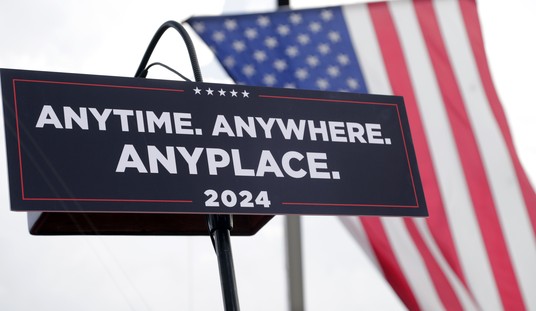Years from now we’ll ask ourselves, “Where were you the day Rasmussen went Never Trump?”
I kid, but a serious case could be made that this is the single worst national poll Trump has gotten all year. Other polls have showed bigger leads for Biden, but between the “house effect” in Rasmussen’s surveys that typically favors Trump plus the fact that Rasmussen polls only likely voters, a 10-point lead for a Democrat in a Ras poll feels even bigger than it is.
This should also lay to rest the conspiracy theory that surveys showing Biden up by nine or 10 are part of some “suppression” effort by pollsters. That would make no sense four months out from an election anyway, but obviously Rasmussen wouldn’t be part of such an effort if one existed. They have the race Biden +10 right now because that’s where the race really is, as various other data has shown.
President Trump trails likely Democratic nominee Joe Biden by ten points in Rasmussen Reports’ first weekly White House Watch survey for 2020.
The latest Rasmussen Reports national telephone and online survey finds Biden earning 50% support among Likely U.S. Voters to Trump’s 40%. Six percent (6%) remain undecided.
The new survey finds Trump with 74% of the Republican vote. Biden has the support of 79% of Democrats. Among voters not affiliated with either major party, it’s Biden 48%, Trump 36%.
I’m not sure what to make of the strangely low degree of partisan support each candidate is enjoying here. Presumably there’s a sizable “leaners” contingent on each side that Ras isn’t counting for this purpose.
There are other indicators of the state of the race right now besides the polling data itself. Harry Enten flagged an interesting one a few days ago, noting that you can always tell who’s ahead in an election by comparing the number of internal polls that each side releases to the public. A few years ago, before the midterms, Democrats publicized far more internal polls than the GOP did. They went on to win 40 seats and take back the House. “Since 2004,” writes Enten, “there has been a near perfect correlation (+0.96 on a scale from -1 to +1) between the share of partisan polls released by the Democrats and the November results.” Over the last three months, the ratio of internal polls released by Democrats and their allies to polls released by the GOP and its allies is 17 to 0.
The Cook Political Report announced this morning that they’re moving Georgia from “lean Republican” to “toss-up,” Wisconsin and Pennsylvania from “toss-up” to “lean Democratic,” and Maine from “lean Democratic” to “likely Democratic.” Amy Walter writes that a wipeout looks increasingly plausible:
This election is looking more like a Democratic tsunami than simply a Blue wave. President Trump, mired in some of the lowest job approval ratings of his presidency, is trailing Biden by significant margins in key battleground states like Pennsylvania (8 points), Michigan (9 points), and Wisconsin (9 points). He’s even running behind Biden in his firewall states of Florida and North Carolina…
Republican strategists we’ve spoken with this week think Trump is close to the point of no return. A couple of others wondered if Trump had reached his “Katrina” moment: a permanent loss of trust and faith of the majority of voters…
[I]f voters start to sense that the race for president is a blow-out, will they be more willing to split their tickets to ensure a ‘check and balance’ in Washington next fall? At least one Republican I spoke with, however, was wary of a check and balance working this year, telling me that “people are looking for a restart and a reset.” That includes down-ballot candidates as well as the president.
It’s not all due to a “Trump effect.” Dave Wasserman flagged this fascinating data point yesterday:
By my estimate, if turnout levels & partisan preferences among 1) non-college whites 2) college whites and 3) non-whites were to remain *constant* from 2016, Biden would flip:
Florida (29 EVs)
Michigan (16)
Pennsylvania (20)
Wisconsin (10)…based on demographic change alone.
— Dave Wasserman (@Redistrict) July 7, 2020
Trump’s base is shrinking irrespective of the things he says and does, although of course the things he says and does could be causing it to shrink faster by convincing some people who didn’t vote Democratic in 2016 to do so this year. Case in point: The Times has a notable example of the “Trump effect” at work within the Democratic base, among whom we’d expect the left to be more hostile to Biden than the center. Biden’s a centrist himself, after all; you would think he’d have no trouble appealing to Amy Klobuchar’s or Pete Buttigieg’s voters but maybe some difficulty winning over Berniebros or Warrenites. The opposite is the truth, says Nate Cohn of the NYT. Klobuchar voters are the most likely to prefer Trump to Biden, splitting 82/9 for Joe with another nine percent preferring another option. Warren voters are practically unanimously behind Biden — 96/0, if you can believe it, with four percent choosing “other.” (Bernie voters broke 87/4.)
In a way that makes sense. Logically, a centrist Klobuchar fan should be more receptive to a right-wing candidate than a left-wing Warren fan should. But it’s always the case in elections that some centrists in each party will find more to like in the other party’s candidate than their own. The big mystery in this election was whether Biden’s squishiness would convince progressives to vote third-party. That was a major potential liability for Sleepy Joe, the sort of thing that might tip the election in a battleground state. Answer so far: No, they’re not breaking away. Their antipathy to Trump seems to have them firmly in Biden’s column right now. If POTUS is going to stage a comeback, it’ll probably involve more Klobuchar-friendly voters in the Democratic center and among independents than it will lefties staying home.








Join the conversation as a VIP Member